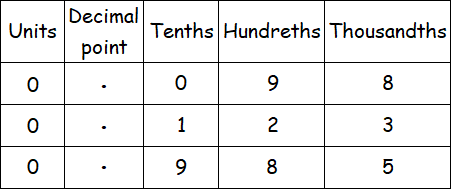COMPARING AND ORDERING DECIMALS WORKSHEET
Subscribe to our ▶️ YouTube channel 🔴 for the latest videos, updates, and tips.
1. Compare 1.031 and 0.256.
2. Compare 0.231 and 0.228.
3. Compare the numbers with the symbols <, > or =.
3.54 ___ 35.4
0.1 ___ 0.01
-2.01 ___ -0.201
0.002 ___ 0.002
5.85 ___ 5.58
4. Order the decimal numbers 1.023, 1.101 and 0.985 from least to greatest.
5. Order the decimal numbers 0.098, 0.123 and 0.985 from least to greatest.
6. Matthew’s best four times for an 80 m sprint are 9.9 seconds, 9.09 seconds, 9.99 seconds and 9.89 seconds. Place these times in order from fastest to slowest.
7. On Monday the US dollar could be exchanged for 0.7211 euros. This means that each US dollar was worth a little more than 72 euro cents. For the rest of the week the exchange figures were: Tuesday 0.7122, Wednesday 0.7201, Thursday 0.7102, and Friday 0.7212. Place the exchange rates in order from highest to lowest.
8. Central Heights High School had five top long distance runners in the City Track Meet. Their fastest times were:
- Jim 43.01
- Sam 44.52
- Paul 43.10
- Karl 45.01
- Hayne 44.66
Arrange the runners’ names in order from first place to fifth place.
9. Circle the number in each group with the least value.
|
|
10. Order the following set of numbers from least to greatest.
845.051 845.115 845.50 840.500

1. Answer :
1.031 and 0.256
To compare the given decimal numbers, we have to write them in a table as given below.

In the above table, compare the numbers in the first column (units).
We have 1 in 1.0231 and 0 in 0.256.
Since 1 is greater than 0, we have
1.031 is greater than 0.256
2. Answer :
0.231 and 0.228
To compare the given decimal numbers, we have to write them in a table as given below.

In the above table, compare the numbers in the first column (units).
In the first column, we have have 0 in both the decimal numbers 0.231 and 0.228.
So, we have to compare the numbers in the third column (Tenths).
In the third column (Tenths), we have the same number 2 in both the decimal numbers.
So, we have to compare the numbers in fourth column (Hundredths).
In the fourth column (Hundredths), we have 3 in 0.231 and 2 in 0.228.
Since 3 is greater than 2, we have
0.231 is greater than 0.228
3. Answer :
3.54 ___ 35.4
0.1 ___ 0.01
-2.01 ___ -0.201
0.002 ___ 0.002
5.85 ___ 5.58
4. Answer :
1.023, 1.101, 0.985
To order the given decimal numbers, first we have to write them in a table as given below.

To get the least one , compare the numbers in the first column (units).
We get 0 in 0.985. This is the least among the given three decimal numbers.
To get the next least number, let us compare 1.023 and 1.101.
In both the decimals, we find 1 in the first column (units).
Now, we have to compare the third column (Tenths). There we get 0 in 1.023 and 1 in 1.101.
Since 0 is less than 1, the next least decimal is 1.023.
Therefore, the order of the given decimals from least to greatest is
0.985, 1.023, 1.101
5. Answer :
0.098, 0.123, 0.985
To order the given decimal numbers, first we have to write them in a table as given below.

To get the least one , compare the numbers in the first column (Units).
We get 0 in all the three decimal numbers in the first column.
So, let us move to the third column (Tenths) and compare the numbers.
In third column, we get 0 in 0.098.
Therefore, 0.098 is the least among the given decimal numbers.
In the same third column, we get 1 in 0.123.
This is the next least decimal number.
Therefore, the order of the given decimals from least to greatest is
0.098, 0.123, 0.985
Note :
In the third column also, if you get the same number in all the three decimal numbers, compare the numbers in the fourth column (Hundredths column) and so on.
6. Answer :
Given quantities are
9.9 seconds, 9.09 seconds, 9.99 seconds, 9.89 seconds
Converting into like decimals,
9.90, 9.09, 9.99, 9.89
Arranging from fastest to slowest,
9.09, 9.89, 9.90, 9.99
7. Answer :
Echange rates on,
- Monday = 0.7211
- Tuesday = 0.7122
- Wednesday = 0.7201
- Thursday = 0.7102
- Friday = 0.7212
Since these are like decimals, we can do the comparision simply
0.7212, 0.7211, 0.7201, 0.7122, 0.7102
Arranging the days from highest to lowest :
Friday, Monday, Wednesday, Tuesday, Thursday
8. Answer :
- Jim 43.01
- Sam 44.52
- Paul 43.10
- Karl 45.01
- Hayne 44.66
Arranging the times from shortest to longest,
43.01, 43.10, 44.52, 44.66, 45.01
Arranging runner's name from first place to fifth place :
Jim, Paul, Sam, Hayne, Karl
9. Answer :
Converting each as like decimals.
|
|
The least value in the first column is 15.999
The least value in the second column is 7.099
10. Answer :
Given decimals are,
845.051, 845.115, 845.500, 840.500
By making it as like decimals, we can compare the decimals simply.
840.500, 845.051, 845.115, 845.500
Subscribe to our ▶️ YouTube channel 🔴 for the latest videos, updates, and tips.
Kindly mail your feedback to v4formath@gmail.com
We always appreciate your feedback.
About Us | Contact Us | Privacy Policy
©All rights reserved. onlinemath4all.com
Recent Articles
-
Quantitative Reasoning Questions and Answers
Dec 14, 25 06:42 AM
Quantitative Reasoning Questions and Answers -
Specifying Units of Measure
Dec 14, 25 06:38 AM
Specifying Units of Measure -
Coin Tossing Probability
Dec 13, 25 10:11 AM
Coin Tossing Probability - Concept - Sample Space - Formula - Solved Problems